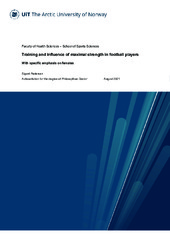| dc.contributor.advisor | Pettersen, Svein Arne | |
| dc.contributor.author | Pedersen, Sigurd | |
| dc.date.accessioned | 2021-11-02T13:56:50Z | |
| dc.date.available | 2021-11-02T13:56:50Z | |
| dc.date.issued | 2021-11-26 | |
| dc.description.abstract | Participation and interest in female football is rising. Football is considered a complex sport, where technical, tactical, and physiological traits are suggested to impact the players´ ability to perform. However, most research on physical testing and training prescription derives from males.
Although research is emerging on the match demands of female football, how underlying physiological or fitness factors are associated with these demands are for the most unknown. For males, a plethora of research describe maximal strength training as an effective means to increase strength, sprint and jump abilities. However, how females should train for strength and explosive abilities to improve football performance is scarcely investigated.
The aims of this thesis were to examine the associations between maximal strength and explosive characteristics and physical match play performance (paper I). Moreover, two studies were conducted to investigate the effects of including systematic maximal strength training during pre-season (paper II) or excluding both maximal strength training and football training during COVID-19 lockdown (Paper IV) on maximal strength and explosive characteristics. One study (paper III) was included to reproduce maximal strength training findings in male football players, as well as comparing whether baseline strength may influence responses between sexes.
The findings of this thesis indicate that maximal strength is of minor importance for physical match play performance in females. Maximal strength training is feasible and effective for increasing maximal strength in both female and male football players, however, only males experienced a transferable improvement in jump and sprint performance. Further, training during the COVID-19 lockdown in Norway, with the prescription of only body weight exercises and without maximal strength training, did not negatively influence maximal strength, sprint times or jump height in female football players. | en_US |
| dc.description.doctoraltype | ph.d. | en_US |
| dc.description.popularabstract | Strength and explosive qualities are suggested to be important in football, however, data in female players are scarce. In this thesis, sprint, and jump, but not strength performance measured in the laboratory were associated with match play. Further, strength training did not improve sprint, jump, and match play performance. Additionally, while both males and females improve strength by strength training, only males experienced an improved sprint and jump performance. Finally, the COVID-19 lockdown period in Norway, did not negatively influence maximal strength, sprint, and jump performance in female players. These findings suggest a limited impact of maximal strength, and maximal strength training on female football performance. This thesis outlines results into female football physiology, that seems to deviate from that of males, highlighting the need for further and detailed investigations to provide an equal knowledge base for training and performance development for both sexes. | en_US |
| dc.description.sponsorship | RDA.
Tromsø Forskningsstiftelse. | en_US |
| dc.identifier.uri | https://hdl.handle.net/10037/22920 | |
| dc.language.iso | eng | en_US |
| dc.publisher | UiT The Arctic University of Norway | en_US |
| dc.publisher | UiT Norges arktiske universitet | en_US |
| dc.relation.haspart | <p>Paper I: Pedersen, S., Welde, B., Sagelv, E.H., Heitmann, K.A., Randers, M.B., Johansen, D. & Pettersen, S.A. (2021). Associations between maximal strength, sprint, and jump height and match physical performance in high-level female football players. <i>Scandinavian Journal of Medicine and Science in Sports</i>. Also available in Munin at <a href=https://hdl.handle.net/10037/22751>https://hdl.handle.net/10037/22751</a>.
<p>Paper II: Pedersen, S., Heitmann, K.A., Sagelv, E.H., Johansen, D. & Pettersen, S.A. (2019). Improved maximal strength is not associated with improvements in sprint time or jump height in high-level female football players: a cluster-randomized controlled trial. <i>BMC Sports Science, Medicine and Rehabilitation, 11</i>, 20. Also available in Munin at <a href=https://hdl.handle.net/10037/16219>https://hdl.handle.net/10037/16219</a>.
<p>Paper III: Sagelv, E.H., Pedersen, S., Nilsen, L.P.R., Casolo, A., Welde, B., Randers, M.B. & Pettersen, S.A. (2020). Flywheel squats versus free weight high load squats for improving high velocity movements in football. A randomized controlled trial. <i>BMC Sports Science, Medicine and Rehabilitation, 12</i>, 61. Also available in Munin at <a href=https://hdl.handle.net/10037/19698> https://hdl.handle.net/10037/19698</a>.
<p>Paper IV: Pedersen, S., Johansen, D., Casolo, A., Randers, M.B., Sagelv, E.H., Welde, B., Winther, A.K. & Pettersen, S.A. (2021). Maximal strength, sprint and jump performance in high-level female football players are maintained with a customized training program during the COVID-19 lockdown. <i>Frontiers in Physiology, 12</i>, 623885. Also available in Munin at <a href=https://hdl.handle.net/10037/21727>https://hdl.handle.net/10037/21727</a>. | en_US |
| dc.rights.accessRights | openAccess | en_US |
| dc.rights.holder | Copyright 2021 The Author(s) | |
| dc.rights.uri | https://creativecommons.org/licenses/by-nc-sa/4.0 | en_US |
| dc.rights | Attribution-NonCommercial-ShareAlike 4.0 International (CC BY-NC-SA 4.0) | en_US |
| dc.subject | VDP::Medisinske Fag: 700::Idrettsmedisinske fag: 850::Treningslære: 851 | en_US |
| dc.subject | VDP::Medical disciplines: 700::Sports medicine: 850::Exercise techniques: 851 | en_US |
| dc.subject | VDP::Medisinske Fag: 700::Idrettsmedisinske fag: 850::Bevegelseslære: 852 | en_US |
| dc.subject | VDP::Medical disciplines: 700::Sports medicine: 850::Movement instruction: 852 | en_US |
| dc.title | Training and influence of maximal strength in football players - With specific emphasis on females | en_US |
| dc.type | Doctoral thesis | en_US |
| dc.type | Doktorgradsavhandling | en_US |


 English
English norsk
norsk
